
The Pyralidae, commonly called pyralid moths, snout moths or grass moths, are a family of Lepidoptera in the ditrysian superfamily Pyraloidea. In many classifications, the grass moths (Crambidae) are included in the Pyralidae as a subfamily, making the combined group one of the largest families in the Lepidoptera. The latest review by Eugene G. Munroe and Maria Alma Solis retain the Crambidae as a full family of Pyraloidea.

Opuntia ficus-indica, the Indian fig opuntia, fig opuntia, or prickly pear, is a species of cactus that has long been a domesticated crop plant grown in agricultural economies throughout arid and semiarid parts of the world. O. ficus-indica is the most widespread and most commercially important cactus. It is grown primarily as a fruit crop, and also for the vegetable nopales and other uses. Cacti are good crops for dry areas because they efficiently convert water into biomass. O. ficus-indica, as the most widespread of the long-domesticated cactuses, is as economically important as maize and blue agave in Mexico. Opuntia species hybridize easily, but the wild origin of O. ficus-indica is likely to have been in central Mexico, where its closest genetic relatives are found.

Cactoblastis cactorum, the cactus moth, South American cactus moth or nopal moth, is native to Argentina, Paraguay, Uruguay and southern Brazil. It is one of five species in the genus Cactoblastis that inhabit South America, where many parasitoids, predators and pathogens control the expansion of the moths' population. This species has been introduced into many areas outside its natural range, including Australia, the Caribbean, and South Africa. In some locations, it has spread uncontrollably and was consequently classified an invasive species. However, in other places such as Australia, it has gained favor for its role in the biological control of cacti from the genus Opuntia, such as prickly pear.

Opuntia humifusa, commonly known as the devil's-tongue, eastern prickly pear or Indian fig, is a cactus of the genus Opuntia present in parts of the eastern United States and northeastern Mexico.

Eumacaria is a monotypic moth genus in the family Geometridae described by Packard in 1873. Its only species, Eumacaria madopata, the brown-bordered geometer moth, was first described by Achille Guenée in 1857. It is found in North America, where it has been recorded from British Columbia, northern Washington, southern Saskatchewan, from Maine to Florida, South Dakota, North Dakota, Nebraska, Wyoming, Idaho, Colorado and New Mexico. The habitat consists of orchards and shrublands. The species is listed as threatened in Connecticut.

Opuntia, commonly called the prickly pear cactus, is a genus of flowering plants in the cactus family Cactaceae, many known for their flavorful fruit and showy flowers. Cacti are well-adapted to aridity, however, they are still vulnerable to alterations in precipitation and temperature driven by seasonal weather changes. Prickly pear alone is more commonly used to refer exclusively to the fruit, but may also be used for the plant itself; in addition, other names given to the plant and its specific parts include tuna (fruit), sabra, sabbar, nopal from the Nahuatl word nōpalli, nostle (fruit) from the Nahuatl word nōchtli, and paddle cactus. The genus is named for the Ancient Greek city of Opus, where, according to Theophrastus, an edible plant grew and could be propagated by rooting its leaves. The most common culinary species is the "Barbary fig".
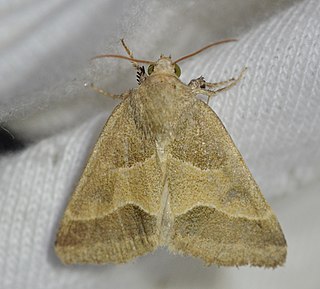
Schinia gracilenta, the slender flower moth or iva flower moth, is a moth of the family Noctuidae. The species was first described by Jacob Hübner in 1818. It is found from the US states of New York to Florida and Nebraska to Arizona. The species is listed as endangered in Connecticut.

Erynnis horatius, commonly known as Horace's duskywing, is a species of butterfly in the family Hesperiidae. It is found in the United States from Massachusetts to Florida, and west to eastern South Dakota, the Gulf Coast, south-eastern Utah, Colorado, north-eastern Arizona, and New Mexico. It is listed as a species of special concern in the US state of Connecticut.

Melitara dentata, the North American cactus moth, is a moth of the family Pyralidae. The species was first described by Augustus Radcliffe Grote in 1876. It is native to western North America, where it is widespread from Alberta to southern Arizona and central Texas. It is an introduced species in Hawaii.
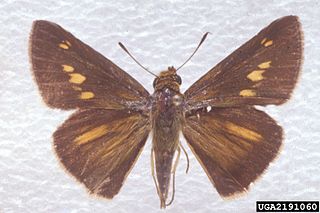
Euphyes dion, the Dion skipper or Alabama skipper, is a species of butterfly of the family Hesperiidae. It is found in scattered populations along the Atlantic coast of North America, from western Massachusetts and south-eastern New York south to north-eastern Florida, west to north-eastern Texas, and north to south-eastern North Dakota, northern Wisconsin, southern Ontario and southern Quebec. It is listed as a species of special concern in the US state of Connecticut.
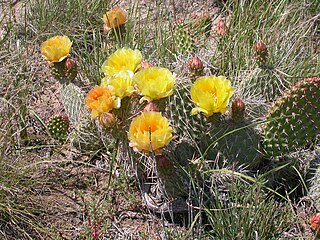
Opuntia polyacantha is a common species of cactus known by the common names plains pricklypear, starvation pricklypear,. and hairspine cactus, panhandle pricklypear. It is native to North America, where it is widespread in Western Canada, the Great Plains, the central and Western United States, and Chihuahua in northern Mexico. In 2018, a disjunct population was discovered in the Thousand Islands region of Ontario, Canada.
Melitara texana is a species of snout moth in the genus Melitara. It was described by Herbert H. Neunzig in 1997 and is found in southern Texas and adjacent Mexico.
Melitara doddalis is a species of snout moth in the genus Melitara. It was described by Harrison Gray Dyar Jr. in 1925, and is found in the United States in southern Arizona, southern New Mexico, south-western Texas and in northern Mexico.
Melitara junctolineella is a species of snout moth in the genus Melitara. It was described by George Duryea Hulst in 1900. It is found in southern Texas and Mexico. The species has been introduced in Australia as a biological control agent of Opuntia stricta.
Melitara subumbrella is a species of snout moth in the genus Melitara. It was described by Harrison Gray Dyar Jr. in 1925. It is widespread in western North America, from southern Alberta and Saskatchewan to southern Arizona, central Texas, southern New Mexico and south-eastern California.
Opuntia ammophila, the devil's-tongue, is a species of prickly pear cactus in Florida. Individuals typically occur singly and do not generally form dense thickets. O. ammophila was once considered a variety of O. humifusa; however, it is a distinct species. Among their many differences, O. ammophila has gray-green cladodes rather than green or grass-green.

Opuntia nemoralis is a species of cactus (Cactaceae) native to the United States. It is found in the South-Central region, in the states of Arkansas, Louisiana, Texas, and with a single specimen tentatively identified from Missouri. Its natural habitat is in sandy prairies, saline and sodic barrens, and rock outcrops.
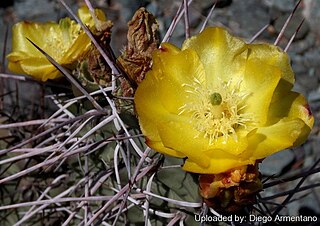
Opuntia sulpurea falls under the Opuntia, or prickly pear, genus within the family Cacataceae named such because of their round shape, green color, and long thick spines. Opuntia sulphurea is the widest spread of the Opuntia that can be found in and around Argentina, occupying mostly arid areas of the region from the plains in the Western portion of Argentina up to much higher altitudes on the Eastern side of the Andes mountain range. As a result of its ability to survive in such a diverse array of environments there are several subspecies of O. sulphurea that are identifiable based on the number of spine per areole, for example. A commonality across the three is a bright yellow flower, often considered to be the color of sulfur, from which the species name is derived. As with several other species of Opuntia, these prickly pears tend to grow in groups, forming clumps that can reach one to two meters in diameter, but while other species within the genus grow upwards as well O. sulphurea tend to stay low to the ground. As a result of its tendency to grow in dry, arid, and rocky areas this cactus has evolved to be very resilient, not even suffering from the effects of agriculture, i.e. cattle grazing, on lower altitude subpopulations.

Opuntia austrina, also known as the Florida prickly pear, is a prickly pear cactus species that is endemic to Florida in the United States.
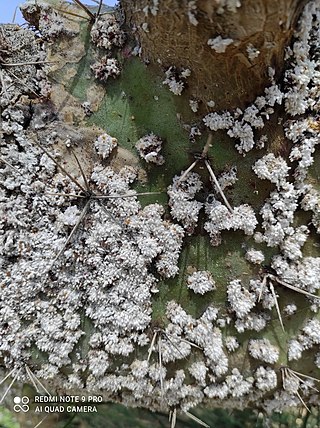
Dactylopius opuntiae, also known as the prickly pear cochineal, is a species of scale insect in the family Dactylopiidae.














